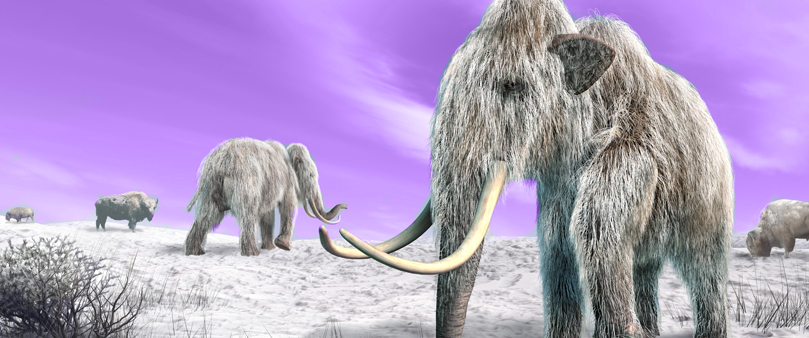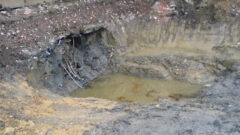
The fight against global warming
Scientists may have found an unlikely ally in the fight against global warming – the woolly mammoth. Instrumental in keeping the earth cool during the last Ice Age, the mammoth– so scientists believe – could do the same for us 11,500 years on.
There’s one problem of course: they’ve been extinct for most of that time. But geneticists are working on reactivating some of the mammoths’ genes by introducing them into elephant cells – with the aim of creating creatures that would be able to survive in the Arctic environments where they could make a difference.
What’s the problem?
Much of the ground in Arctic regions is covered with permafrost – thick subsurface layers of soil that stay frozen all the time. This soil contains vast amounts of carbon from dead plants – estimated to be about twice as much as that currently in the atmosphere. As long as the soil stays frozen, there’s no problem; but if it thaws, microbes will break the plant material down, releasing carbon dioxide and methane into the atmosphere. This would accelerate climate change, causing global temperatures to rise even further than is currently predicted.
How can mammoths help?
During the Ice Age, much of the earth was steppe – grassland plains with very few trees, populated by bison, reindeer, tigers and woolly mammoths. There were few trees because the mammoths and other large herbivores were kind of clumsy, constantly trampling on moss and shrubs and uprooting trees as they stomped around. This was good – it kept the steppes as unforested grassland, which meant there was a plentiful food source for the animals.
But it also helped to keep the ground cool. Grass absorbs less sunlight than trees, so the ground doesn’t get so warm and the permafrost is less likely to melt. Large numbers of animals trampling on and disturbing snow cover will also reduce its insulating effect on the ground and expose the earth to the cold instead. So, the idea is that if mammoth-like creatures lived in the Arctic tundra today, they could help keep the earth cool in a similar way and prevent the permafrost from melting.
In fact, scientists have been conducting an experiment in Siberia called Pleistocene Park since 1996. Founded by Russian geophysicist Sergei Zimov, the 16 sq km park is home to around 100 animals roaming free, including bison, musk ox, moose, yaks, horses and reindeer. The aim is to determine if the animals can turn the landscape into fertile pastures and slow or even reverse permafrost thaw – and early evidence suggests they can. In May, Paul Mann, senior lecturer in geography and environmental sciences at Northumbria University, reported that the park’s grasslands were reflecting more sunlight than the surrounding forests, and reducing the heat penetrating the ground.
So how do you make a mammoth?
In 2015, a team of researchers at Harvard successfully inserted 14 woolly mammoth genes into the genome of the mammoth’s closest living relative, the Asian elephant. This won’t make mammoths, but may produce elephant cells with genes for a few of the mammoths’ major characteristics: the ability to grow a thick coat, lay down a lot of body fat, and transport oxygen around the body efficiently at low temperatures. Cell biologist Helen Pilcher referred to the putative animal as a mammophant.
So how do you turn a few elephant cells into a whole mammophant? The scientists’ preferred option would have been to use elephants as surrogate mothers to give birth to baby mammophants, but the elephants are endangered and there are barely enough of them to keep their own species going. Instead, they are seeing if they can grow the babies in artificial wombs.
Is this the right thing to be doing?
Cloning and genetic engineering are controversial topics which raise serious ethical questions – including the issue of whether animals should be genetically manipulated in the service of humans. There is also the question of whether it is right, or sensible, to invest time and resources resurrecting the genes of an extinct species which could instead be directed towards saving the endangered elephants themselves. To reiterate the salient point made by Dr Ian Malcolm in Jurassic Park, are we so preoccupied with whether we could, that we haven’t stopped to think whether we should?
Dr Mann agrees: “A key question is whether we need mammoth specifically to make these projects work. Could we not simply knock down trees manually, and use existing animals?” However, he added: “Tackling global climate change needs ambitious, novel and often epic solutions, and at the moment we lack a decent solution for keeping the giant Arctic carbon deposits in the ground.”
You may not be reviving a species that’s been extinct for thousands of years, but if your work involves pioneering scientific research,you may be entitled to financial help from the government through r&d tax claims. The research and development tax credit is there to support research which aims to make people’s lives better – and as R&D tax specialists, we can do the work on your application for you. Contact us today to find out more.





